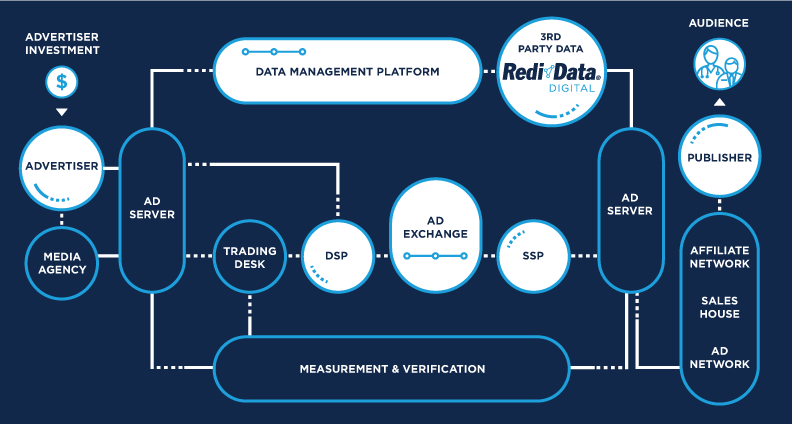Programmatic advertising has become a key tactic for marketers to target specific audiences with ads, primarily digital, using precision and scale. According to eMarketer, about 86.5 percent of marketers of digital display ad dollars have been spent towards programmatic buying! As medical brands look for new solutions to enrich their advertising strategies and healthcare lists, more marketers are turning to programmatic advertising to target audiences on various platforms. However, the programmatic digital media supply chain is a bit complicated and can get confusing.
We are going to break it down into “what is it, how does it work, and why does audience data play such an important part?” By the end of this, you should have a better understanding of what programmatic advertising is and how it can help you expand your marketing reach!
An Introduction to Programmatic Advertising – What Is it?
Programmatic advertising is an automated system built for the buying and selling of ads using a real-time bidding (RTB) process, unlike the days of RFPs, negotiations, and insertion orders. Not only does it automate the buying and selling of ads, but the technology’s advancements also allow marketers to serve up ads to the right audience, with the right message, at the right time and place.
Targeting specific audiences through programmatic advertising can help create more personalized, one-on-one experiences with ad recipients than with traditional strategies. These ads are not just personalized to their interests and needs. They can also reach recipients on their most utilized channels – anytime, anywhere – through mobile, video, CTV (connected TV), social media, and more.
How Does It Work?
The programmatic supply chain can be rather complex, but we will focus on the basics of buying and selling, or as it also is known – the Supply (Publisher) and Demand (Advertiser) sides. There are multiple ways advertisers can go about buying inventory, also known as ad space, but how they acquire it through this process all depends on the type of programmatic ad buying that is in place by publishers.
Before the buying and selling process happens in what’s called the ad exchange, publishers and advertisers must decide what they want to put on their different platforms. Publishers use a Supply-Side Platform (SSP) to securely sell their inventory on the ad exchange. Meanwhile, advertisers use a Demand-Side Platform (DSP) to store their creatives.
Auction-Bidding
Looking at how inventory is bought, most brands buy inventory using the auction-based process of RTB. RTB allows publishers to make their inventory available to all buyers in an ad exchange. In a simple RTB public auction, each bidder proposes a CPM (cost per thousand) based on their own value of the inventory, with the highest bidder winning the space for their ad to be shown.
Another type of RTB auction occurs in a Private Marketplace (PMP), where a publisher selects a certain number of buyers to bid on inventory. Publishers can also sell ad space though exchanges that are not auction-based. In a process called Programmatic Direct, the exchange only occurs between the publisher and one brand. The publisher can sell multiple properties, and they can determine their inventory’s performance and how brands can optimize it. Since this is not part of a bidding process, the price is at a fixed, premium CPM that can be negotiated between the buyer and seller.
Why Does Audience Data Play Such an Important Role?
Audience Data is key when planning and executing marketing strategies around programmatic advertising, as it is an essential tool for marketers to maximize the reach and effectiveness of their target audiences.
Okay, but how does this type of data play a direct role in the programmatic process? Typically, marketers will use their own first-party data to identify the audiences they want to target in their programmatic advertising efforts. To be able to reach new audiences, data partners can provide third-party data of individuals with characteristics reflective of a brand’s first-party data.
This type of third-party data is known as probabilistic data, which segments audiences based on the characteristics and behaviors. Probabilistic data is ideal for advertisers who want to target individuals who share the same interests and habits. This is different from deterministic data, which consists of unique identifiers that help determine who individuals are. Deterministic data includes information provided by the individuals themselves like their email address, phone number, usernames, and more.
Deterministic data is often used in healthcare marketing campaigns to target very specific healthcare providers (HCPs) on a 1:1 basis using criteria like NPI#. With tools like Redi-Data Digital, you too can market HCPs with such precision and scale. Marketers leveraging third-party data with Redi-Data Digital’s automated and custom segments can target HCPs of their choosing and increase engagement, overall outperforming other HCP marketing efforts.
Now that the Advertiser has won its bid and their target audience is set, the Publisher reserves the space, and it’s time to launch the campaign! Keeping track of metrics like viewability, CTR, and KPIs is necessary, as it helps marketers understand the campaigns’ effectiveness and ensure whether they’re hitting the right audience.
Since we have explained the What, How and Why of Programmatic Advertising – you are ready to start diving deeper and see how Programmatic can work for you!
Check out our Programmatic Glossary for a handy reference to key terms in the programmatic space.
Want to learn more about boosting your data strategy with third-party data? Our data specialists are here to help – contact us today!
Source:
1 – eMarketer US Programmatic Report Part 2 May 2020_Final.pdf

